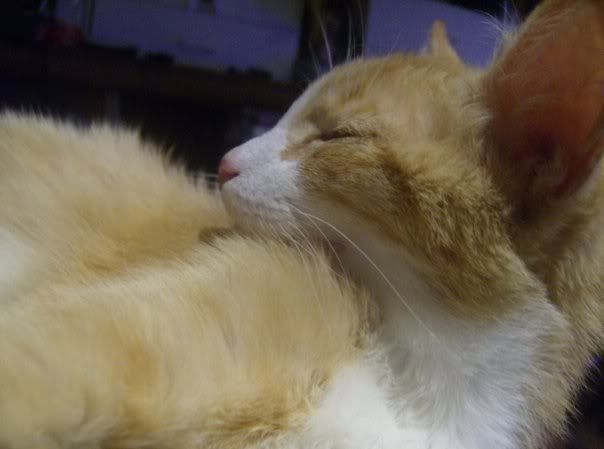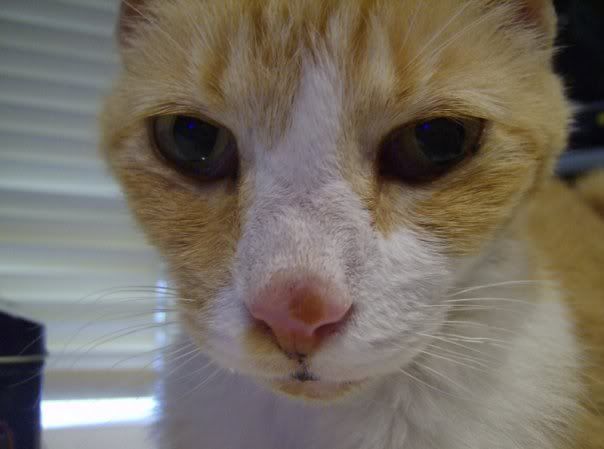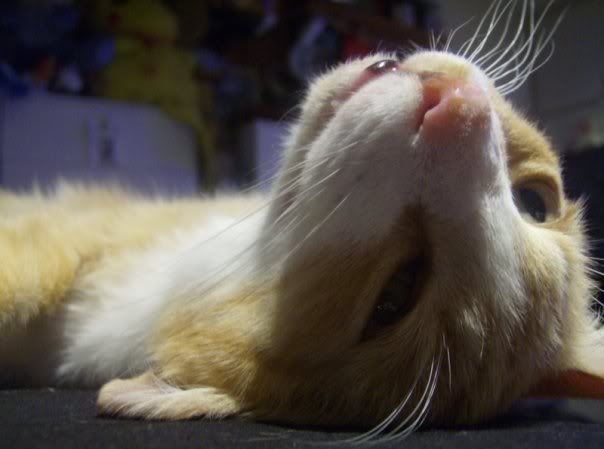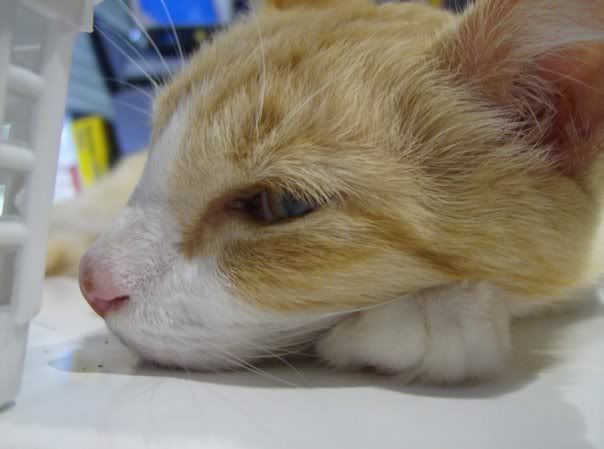EVERYONE, WE DID IT!!!

^ Spot's Shaved Belly ^
Sorry it took a few days but here's the scoop on Spot's injection:
We stopped Spot's pills a week before her injection as instructed by the vet. Then, last Friday we got up at 8 AM, fed Spot, put her in her carrier and started on our hour and a half drive to Miami. (Traffic down here is AWFUL!)
We got to the vet's early and filled out the paper work. The office was really nice and had lots of neat animal artwork. We recognized Dr. Mears immediately from his picture on the internet.
In the waiting room we met one other cat who was getting an injection. His name was Tuxedo. =]
Finally it was our turn. We went back to the exam room where the vet tech and Dr. Mears looked over Spot. Then they took her back for an EKG and ultrasound to make sure she was healthy enough for the injection and sent us on our way.
Later that day we got a call saying they had shaved her stomach for the ultrasound and a spot on her back for the injection and that they had given her the shot.
The vet tech called us several times over the next few days to give us updates. He said Spot was tired and not eating that much but that was to be expected. Sunday night he called and said she was doing better and would be ready to come home Monday afternoon.
We picked her up Monday and were given special instructions for her care over the next two weeks.
We had to wash our hands after touching her and avoid prolonged petting and cuddling. She wasn't supposed to sleep with us and we had to use litter box liners and gloves to clean up after her. We had to change her litter everyday and dispose of it down the toilet as it would be radioactive.
But all in all, Spot was just happy to be home. The little changes didn't seem to bother her. Well, we have about a week and a half more to go then we should be back to normal.
In a few weeks, Spot is going to see her old vet, Doctor Shank, and get her thyroid levels checked again. They should be really low at first and then eventually go back to normal. We'll keep you updated!




Update: 02.06.2009
THE BIG DAY IS FINALLY HERE!
Spot's owner here: Spot is at the vet RIGHT NOW getting ready for her shot!!! They are doing an ultrasound and EKG to make sure she is healthy enough for the injection and then they will give us a call when they are good to go. She has a slight heart murmur that they are checking on but it shouldn't be a problem. I'm working tonight but I'll update as soon as I can.





Friday, October 3, 2008
What is Feline Hyperthyroidism?
Hyperthyroidism is the most common endocrine disorder in cats. It occurs when a tumor is present on the thyroid gland (in the neck) causing it to produce excess amounts of thyroxine (T4) and triiodothyronine (T3) which can be devestating to the cat's health.
WHAT ARE THE SYMPTOMS?
The elevated T4 levels cause extreme weight loss, hyperactivity, and increased appetite, thirst, and urination. Vomiting, diarrhea, and heart problems including heart failure are also common,
HOW IS IT DIAGNOSED?
Feline Hyperthyroidism is diagnosed with a simple blood test that measures the T4 levels in the blood. Normal T4 levels are generally between 1 and 4. (Spot's was 16!)
WHAT ARE THE TREATMENT OPTIONS?
Hyperthyroidism can be treated 3 ways.
>Medication
>Surgery
>Radioactive Iodine injection
MEDICATION is in the form of Methimazole and is commonly given in 5mg tablets twice a day. This treats the symtoms of hyperthyroidism but not the cause. The tumor will continue to grow but the T4 levels are controlled. Medication is expensive: $30 to $60 USD each month and pills must be given orally twice a day to be effective. Pilling a cat is stressful, uncomfortable, and sometimes difficult and the pills, though effective, must be given for the rest of the cat's life. Going out to town is impossible unless Kitty comes with you or you have a very dedicated friend or family member willing to take over your cat pilling duties while you are gone.
SURGERY is not only highly invasive and expensive (usually more than $1,000 USD) but the results depend greatly on your veterinarian's skills as a surgeon. Thyroid surgery is difficult, at best. Remove too much and the cat can suffer from hypothyroidism (T4 levels that are too low) or hypocalcimia (deminished calcium production). Remove too little and the tumor can grow back making the surgery pointless. Additionally, there are the usual risks of surgery and annesthesia including death.
RADIOACTIVE IODINE (I-131) THERAPY is the treatment of choice. The radioiodine is given in a single injection and absorbed by the tumor killing it but leaving all healthy tissue unharmed. The cat must remain "hospitalized" for 3 to 10 days after the injection until it's radiation levels return to normal. After this one injection, thyroid levels should return to normal and no further medication or treatment is needed! The cost of this option is the only downfall: Approximately $1,200 USD.






No comments:
Post a Comment